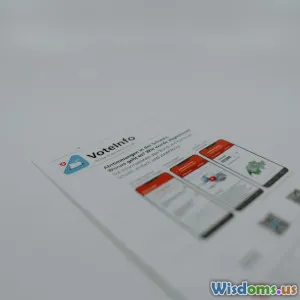
The Surprisingly Easy Way to Cut Funding Requirements
16 min read Discover actionable strategies to reduce funding needs without compromising your project's success. (0 Reviews)
The Surprisingly Easy Way to Cut Funding Requirements
Every ambitious project faces a common obstacle: securing the necessary funds. Whether you’re launching a tech startup, running a non-profit, or rolling out a new product line, funding requirements can often seem daunting—sometimes even insurmountable. But what if you could dramatically reduce the capital needed to accomplish your goals? Rather than fixating solely on raising more money, savvy leaders and organizations are achieving more with less. In this article, we'll reveal strategies—surprisingly straightforward—that can shave off significant portions of required capital without sacrificing quality or outcomes.
Reinvent Project Scope for Lean Success

One of the most effective ways to cut funding requirements is reframing your project scope. Projects frequently get bloated with nice-to-haves that, while attractive, don’t drive the core mission forward. This phenomenon is known as scope creep, and it often sneaks in through optimistic brainstorming or when aiming to please every stakeholder.
The Power of MVP
Rather than aiming for a feature-rich solution, hone in on the Minimum Viable Product (MVP) or service. For instance, Dropbox famously launched with a simple demo video to validate interest. They didn’t build a full-featured sharing platform at first—they trimmed their scope and focused on verifying demand. This approach not only slashed development costs but also attracted investment based on demonstrated need, not hypothetical features.
A Real-World Example: Charity: Water
Nonprofit organizations like Charity: Water apply this principle by crowdfunding for just the essentials needed to fund a water project—sometimes even breaking down projects into micro-campaigns that attract more donors due to transparency. The clarity of scope inspires confidence and makes the funding target easier to hit.
Before committing resources, critically examine every part of your plan:
- Which features or steps are absolutely essential?
- Can you split your project into phases with tangible milestones?
- What can you postpone until you have more resources?
Methodically pruning your deliverables doesn’t diminish your vision—it supercharges your efficiency.
Embrace Cost-Saving Technologies and Automation

Technological advancements don’t merely open new possibilities—they empower dramatic cuts to resource requirements. Embracing smart technology can be the single largest differentiator in today’s funding landscape.
Cloud Solutions Over Infrastructure Investments
Traditional business models required heavy upfront investments in physical infrastructure and licensed software. Today, cloud-based solutions like AWS, Azure, and Google Cloud have rendered massive server purchases virtually obsolete. Example: Netflix transitioned entirely to the cloud to minimize infrastructure costs and gain scalability—allowing more resources to be funneled into content creation instead of data centers.
Automate, Then Delegate
Robotic Process Automation (RPA) tools like UiPath, Blue Prism, and Automation Anywhere have enabled organizations to automate repetitive tasks such as data entry, invoice processing, or customer service inquiries. A 2022 Deloitte survey found that 53% of surveyed businesses slashed operational costs by adopting automation tools.
Consider how this savings played out for a mid-sized insurance company: by automating policy renewal notices and claims intake (often handled manually), it reduced required funding for administrative overhead by nearly 40% in the first year alone.
Leveraging Open Source
Open source software can eliminate expensive licensing fees, foster customization, and bring in community support for troubleshooting and upgrades. Tools like WordPress, Odoo ERP, and Linux have fueled growth for startups on shoestring budgets.
Stock Up on Strategic Partnerships and Resource Sharing

You don’t have to go it alone. Sharing resources or forming alliances can dramatically shrink funding needs. By strategically partnering or participating in collaborations, entrepreneurs and organizations can access vital capabilities without expensive outlays.
Vendor Partnerships
Sometimes, vendors are willing to provide product discounts, deferred payment terms, or shared-investment pilots if your offering complements theirs. For example, hardware manufacturers often co-market software solutions on a revenue-sharing basis, reducing the start-up’s direct out-of-pocket expenses.
Co-working and Shared Spaces
Office rent can drain budgets. Many successful startups—Mailchimp, Uber, and Instagram among them—began in shared or co-working facilities, where resources like high-speed internet, meeting rooms, and administrative staff are pooled, leading to substantial savings compared to traditional leases.
Joint Ventures and Consortiums
In 2023, a group of biotech firms in San Diego formed a consortium to share high-end lab equipment—a single DNA sequencer that would have cost $600,000 to purchase was instead co-leased for a fraction of the price. Collaborating doesn’t mean giving up control; it means leveraging collective strength to reduce individual funding burdens.
Adopt Agile and Iterative Funding Models

Gone are the days when you had to raise a single, colossal funding round. Progressive organizations now use iterative, milestone-driven approaches to fundraising—commonly known as agile financing.
The Milestone-Based Approach
Instead of projecting 18 months of cash needs, break your project into critical phases. Raise just enough funding to accomplish and validate each phase—then leverage achieved results to justify, or even increase, subsequent rounds of investment.
For example, Crystal Knows, a personality AI startup, raised $400,000 to launch a basic version, attracted over 10,000 users, and then used the data to secure $5 million. Each step forward reduced risk for investors—rewriting the startup funding playbook.
Crowdfunding as Agile Validation
Platforms like Kickstarter, Indiegogo, and GoFundMe exemplify this model: Creators set modest initial goals, validate public interest, then re-invest proceeds for full-scale launch. Oculus Rift—a $2+ billion eventual acquisition—started with a $250,000 Kickstarter campaign.
This agile mentality not only trims upfront requirements but builds trust and traction along the way.
Tap the Power of Remote and Flexible Work

Expensive leases, relocation, and onsite processes dramatically inflate funding needs. However, the remote work revolution—accelerated due to global events—has shown how eliminating rigid overhead can multiply savings.
Dismantle the Classical Office Model
Pioneers like GitLab and Basecamp have thrived with fully remote, globally distributed teams. By forgoing physical offices, these companies redirected savings into compensation, hiring, and strategic plays, rather than into real estate or utilities.
Gartner estimates that the average U.S. company saves up to $11,000 per year for every employee who works remotely half the time—adding up quickly in sizeable organizations.
Flexible Staffing
The gig economy and freelance platforms (e.g., Upwork, Toptal, Fiverr) enable businesses to access specialized skills for finite projects without the expenses of recruiting, onboarding, and providing long-term benefits. For a product launch, hiring a freelance designer or marketer trims the funding required for permanent hires or expensive agencies.
Flexible talent models also let organizations scale up (or down) according to need, maximizing capital efficiency.
Negotiate and Optimize Supplier and Service Contracts

You might be surprised at how much funding you can free up simply by reviewing (or renegotiating) supplier and contractor agreements. Many businesses overpay for services due to inertia or lack of market knowledge.
Strategic Sourcing 101
Regular supplier audits can reveal lower-cost alternatives—and suppliers are often open to renegotiating terms to preserve your business long-term. Switch to annual payment structures for discounts; consolidate purchases to tap volume rates; pit vendors against each other for the best deal.
One midwestern hospital system saved over $2 million by renegotiating contracts with its medical supply chains. They streamlined the number of vendors, leveraged competitive bids, & uncovered significant price discrepancies for commonly used items—from gloves to diagnostic test kits.
Don’t Forget the "Hidden" Contracts
Subscriptions to software, databases, professional memberships, or convenience services should be reviewed quarterly. A global survey by SailPoint found that organizations waste nearly 20% of their SaaS spend on under-utilized software licenses. By simply right-sizing subscriptions or replacing them with free-tier alternatives, organizations can redirect funds to where they matter most.
Incorporate Bootstrap Mindsets: Do More With Less

Startups are famous for their scrappiness. Embracing a "bootstrap" mindset—focusing on high-impact, low-cost solutions—can shrink your funding requirements while fostering creativity and discipline.
Sweat Equity and Founder Involvement
Many successful startups conserve precious funds by founders taking on multiple initial roles. Stewart Butterfield, Slack’s founder, not only contributed to early coding but also managed customer support to stay directly connected with users—facilitating product/market fit while saving on hires early on.
Revenue Before Funding
Instead of waiting for a perfect launch, some organizations bring in customers earlier, using pre-orders, beta releases, or paid pilots. Zappos famously started by posting photos of shoes from local stores on a basic website to assess actual demand—minimizing both upfront purchase commitments and funding needs.
Applying bootstrapping principles not only reduces cash required, it builds operational discipline and sharpens decision-making, often resulting in stronger long-term outcomes.
Seek Non-Dilutive and Alternative Funding Sources

Alternative financing options can fulfill capital needs without giving up control or building in high expectation from equity investors.
Grants and Subsidies
Government grants (like the U.S. SBIR program for small businesses), innovation funds, and local business incubators provide non-repayable funding. In 2023, over $3 billion in non-dilutive U.S. government funds supported early-stage R&D.
Revenue-Based Financing (RBF)
With RBF, investors provide capital in exchange for a fixed percentage of future revenues—without ceding equity or putting personal assets at risk. This model has recently boomed in SaaS and ecommerce, where predictable future cash flows make everyone happy.
Microloans and Community Investment
For smaller projects, local credit unions, microloan funds (like Kiva), and even regional development agencies provide flexible, mission-aligned capital solutions.
Be exhaustive in seeking non-traditional sources: smaller checks can sometimes get you further than an arduous equity round or high-interest commercial debt.
Master Data-Driven Decision Making to Eliminate Waste

Perhaps the easiest way to cut funding requirements is having a crystal-clear picture of what truly works. Using analytics and data visualization tools, organizations identify what generates results—and what wastes precious capital.
Pinpoint High-Expense, Low-Return Activities
For example, an events company noticed through data analysis that local street-level marketing, although expensive, delivered far fewer attendees per dollar spent than digital ads. By redirecting those funds based on proven ROI, they trimmed marketing costs by a third while growing attendance.
Regular KPI Reviews
Set clear key performance indicators (KPIs) for every major spending category—then adapt based on what the numbers show. Tools like Tableau, Power BI, or even Google Analytics can surface hidden inefficiencies. One consulting firm used Tableau to identify expense spikes related to travel vendors and saved over $325,000/year by switching service providers.
Make "Surprisingly Easy" a Habit

Reducing funding requirements isn’t about dramatic sacrifices or penny-pinching yourself into irrelevance—it's about building a culture that rewards efficiency, innovation, and resourcefulness. By baking lean thinking into daily operations and empowering teams to ask "is there an easier way?" you lay the groundwork for continual gains.
Organizations like Toyota have institutionalized kaizen—continuous improvement—which has led to decades-long industry leadership. For your next project, test just one or two of the above strategies. Share successes (and failures) openly, so others learn. Before you know it, cutting funding requirements won’t just be a strategy; it will be second nature, propelling you further and faster toward your goals with less capital at risk.
Rate the Post
User Reviews
Other posts in Business Strategy
Popular Posts
















